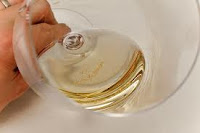White
wines are judged to be the mainstays for summer. Their crisp, acidic flavors go well with white meats and
those summer specialties, potato salad, veggies, even Gazpacho!
We
usually expect summer whites to be chilled and cool, but go don’t go overboard
and freeze them. Lightly chilled
will keep the wines fresh, crisp, aromatic, and cool – perfect for hot weather
drinking.
 Summer
time is salad time and, yes; there are wines that pair well with a salad. The first thing to consider is the
dressing you’ll be using. One with
a lot of acid and vinegar will compete with a wine. Look for a more mellow dressing and pair the wine according
to what’s in your salad. Topping
that salad with fruit? Check out a
Riesling or Traminette. Fresh
berries? Head for a Pinot Noir or
Beaujolais. Is your salad heavy on
the herbs? Select a wine with
herbal-notes like non-oaked Merlot or Sauvignon Blanc.
Summer
time is salad time and, yes; there are wines that pair well with a salad. The first thing to consider is the
dressing you’ll be using. One with
a lot of acid and vinegar will compete with a wine. Look for a more mellow dressing and pair the wine according
to what’s in your salad. Topping
that salad with fruit? Check out a
Riesling or Traminette. Fresh
berries? Head for a Pinot Noir or
Beaujolais. Is your salad heavy on
the herbs? Select a wine with
herbal-notes like non-oaked Merlot or Sauvignon Blanc. If
you’re grilling white meat, chicken, pork or fish, and want a white wine,
consider a lightly chilled bottle of Chenin Blanc or Sauvignon Blanc, both go well with white meats and veggies.
If
you’re grilling white meat, chicken, pork or fish, and want a white wine,
consider a lightly chilled bottle of Chenin Blanc or Sauvignon Blanc, both go well with white meats and veggies.
If
you’re grilling bold flavors, be sure to match your wine to the main flavor
profile. This could be the meat
itself or the sauce or marinade you’ll be using on it. If it’s a BBQ burger or a steak, go for
a robust red, a non-oaked Shiraz or Malbec can handle this. If you’re grilling chicken or chops but
want a red wine, check out a Merlot or Pinot Noir. Both offer a softer red flavor without overwhelming the
white meat.
If
you want to pair a wine with chips and dips, try a young sparkling wine. Those fresh, crisp bubbles help cut the
greasy chip taste away.
 If
you’re looking for a ‘one size fits all’ wine for summer – consider a Rosé. It’s a food-friendly wine and can be served room temperature
or chilled.
If
you’re looking for a ‘one size fits all’ wine for summer – consider a Rosé. It’s a food-friendly wine and can be served room temperature
or chilled.  Or make your own Sangria! Cool, refreshing and another great
summer wine option. Light, fruity
flavors beg to be enjoyed during the summer.
Or make your own Sangria! Cool, refreshing and another great
summer wine option. Light, fruity
flavors beg to be enjoyed during the summer. And
don’t forget, a light, sparkling wine can make a summer afternoon more
bearable. Have it with cold food, hot food, or just because you've finished
cutting the grass!
And
don’t forget, a light, sparkling wine can make a summer afternoon more
bearable. Have it with cold food, hot food, or just because you've finished
cutting the grass!
Here
are ten great summertime wines, perfect for steamy days and sultry nights:
1) Sauvignon
Blanc,
2) Chenin Blanc
3) Traminette
4) Merlot
5) Pinot Noir
6) Rosé
7) Sangria
8) Muscato
9) Vidal Blanc
10) Sparkling wines
Use these to experiment with, then dive in and discover what you like. Find a great pairing? Let us know! Just remember to keep it fun and light - After all, it’s summer – Enjoy!
2) Chenin Blanc
3) Traminette
4) Merlot
5) Pinot Noir
6) Rosé
7) Sangria
8) Muscato
9) Vidal Blanc
10) Sparkling wines
Use these to experiment with, then dive in and discover what you like. Find a great pairing? Let us know! Just remember to keep it fun and light - After all, it’s summer – Enjoy!
~
Joy
















































